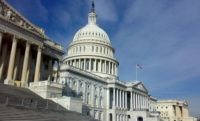A two-year bipartisan agreement to increase overall federal discretionary spending caps is heading for final congressional approval. But the measure is silent about how much money individual programs—including construction and infrastructure accounts—would get in fiscal years 2020 and 2021.
And unlike the last two-year budget deal, which covered fiscal 2018 and 2019, the new one has no provision calling for a general increase per year in overall infrastructure spending.
Decisions on infrastructure line-items will come from congressional appropriations committees in coming months. Sean O’Neill, Associated General Contractors of America vice president for congressional affairs, says of the budget pact, “It remains to be seen, I think, how it’ll impact federal construction accounts.”
The House approved a bill codifying the agreement—the Bipartisan Budget Act—on July 24 on a 284-149 vote. The Senate is expected to pass the measure during the week of July 29. President Trump has said he supports the legislation.
According to a summary of the budget pact, the 2020 limit for the nondefense sector—which houses most construction and infrastructure programs—would be $624 billion, up $27 billion, or 4.5%, from this year.
The fiscal 2020 defense cap, including military construction, would be set at $738 billion, an increase of $22 billion, or 3.1%.
For 2021, the nondefense cap would rise a further $2.5 billion from 2020; the defense limit also would climb, but by just $1.5 billion from 2020.
In the previous two-year budget deal, congressional negotiators specified that overall federal infrastructure funding should increase by $10 billion per year, language that the engineering and construction industries were happy to see.
Lawmakers appear to have exceeded those targets. AGC has calculated that enacted construction-related appropriations totaled $144.3 billion in 2018 and $148.8 billion in 2019, compared with 2017’s $123 billion.
Industry's goals
As infrastructure advocates look ahead to the coming fiscal 2020 appropriations negotiations, they, at the least, don’t want to see any retrenchment from the spending gains of 2018 and 2019.
O’Neill says, “The baseline for these programs is what was enacted for fiscal years ’18 and ’19. And that is what we’re assuming, I think, going forward into the next two fiscal years.”
Steve Hall, American Council of Engineering Companies senior vice president for advocacy and external affairs, says, “At a minimum, we hope this [increase in caps] at least keeps in place the higher funding level that resulted from the previous two-year deal.”
He adds, “There’s a lot of support, from a broad spectrum of groups, for the infrastructure accounts. So I think it’s a reasonable expectation that we can build on [fiscal 2019 levels], but we still have some work to do.”
Joung Lee, American Association of State Highway and Transportation Officials (AASHTO) director of policy, says he thinks the new caps may provide an opportunity for further increases for transportation infrastructure.
“I don’t think it will be as much as it was the last two years, in ‘18 and ’19,” Lee says. “But there is still room to go above and beyond the [Highway] Trust Fund dollars.”
House's 2020 numbers
The House already has approved 10 of its 12 fiscal 2020 appropriations measures—each covering one or more federal departments or agencies—using overall spending ceilings contained in a House Budget Committee measure.
Those numbers were viewed as being on the high side, compared with what was expected to emerge from the budget cap negotiations.
A House Appropriations Committee aide told ENR that the final caps deal provides $5 billion more for the defense sector in 2020 but $15 billion less for nondefense, compared with the figures the House committee used as guidelines in drafting its bills. Those measures recommended increases for some infrastructure accounts, but reductions in others. [View earlier ENR story on appropriations here.]
ACEC's Hall calls the House appropriators' numbers "aggressive," but adds, "That'll be helpful in conference," referring to the eventual final negotiations with the Senate.
It's possible that final numbers for some infrastructure programs will be lower than those in the House-passed bills, as appropriations negotiators seek to keep discretionary spending under the newly agreed-upon caps. Cuts in some accounts from their enacted 2019 numbers also aren't out of the question.
Cap exemptions: highways, airport grants
But transportation and construction officials note that two key programs, federal-aid highways and Airport Improvement Program grants, are exempt from the caps and thus protected from cuts, because they draw from trust funds.
AASHTO's Lee says, "One of the benefits of the trust fund programs, among many, in terms of stability of funding is [they're] not subject to the budget caps." He says the exemption originated in the 1985 Balanced Budget and Emergency Deficit Control Act, also knows as the Gramm-Rudman-Hollings act.
Appropriators still have to set annual obligation limits for highways and airport grants, however.
That leaves 2020 spending levels for all other construction accounts up in the air, including Army Corps of Engineers civil works, General Services Administration federal buildings, Environmental Protection Agency water infrastructure and Defense Dept. construction, among others.
AASHTO was disappointed that the budget deal negotiators didn't include a provision to repeal a $7.6-billion rescission in highway contract authority that is part of the current surface transportation measure, the 2015 Fixing America's Surface Transportation Act. It would result in that amount of funding's being withheld from states on July 1, 2020.
Lee says canceling the rescission "remains a critical issue" for AASHTO. [View ENR story on the rescission here.] Officials will look for other legislative vehicles for a repeal.
The budget agreement overall is a major step forward. Besides establishing new, higher spending limits for appropriators to work within, it also dispels the spectre of mandatory budget cuts under the sequestration process.
Along with its spending limits, the budget legislation also suspends the national debt limit for two years, through July 31, 2021, averting a possible government default.
The looming prospect of breaching the debt ceiling was a major factor in getting congressional and Trump administration leaders to strike a deal on the legislation.
Looking ahead
As for fiscal 2020 appropriations, attention next will focus on the Senate, where appropriators haven't yet moved any of the spending bills for that year. AGC's O'Neill says, "The Senate's been on hold, waiting for this [caps deal] to happen. They'll hit the ground running in the fall and we'll see how this shakes out."
Senate appropriators will "move what they can through committee and the floor and then conference." O'Neill adds.
But Congress will face a tight deadline when lawmakers return after Labor Day from their August recess. O'Neill doesn't expect all of the spending bills to be enacted by Sept. 30, when fiscal 2019 ends. He says, "We should anticipate a stopgap bill prior to the expiration of the fiscal year."




Post a comment to this article
Report Abusive Comment